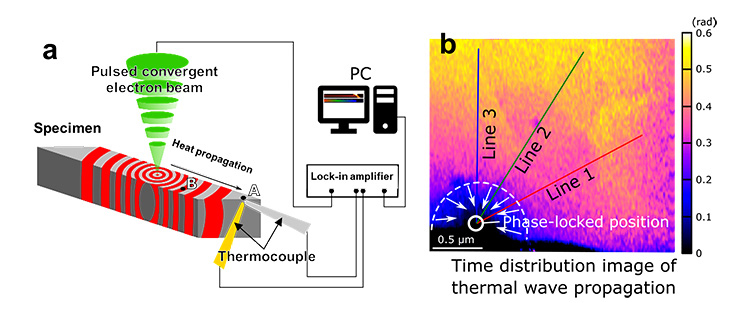 Press Release 2024
Press Release 2024
In-Situ Observation of Nanoscale Heat Propagation
—New Electron Microscopy Technique Developed for Thermal Diffusion Measurements—
Japan Science and Technology Agency (JST)
A NIMS research team has developed a technique that enables the nanoscale observation of heat propagation paths and behavior within material specimens.

Figure. Schematic of the principle and acquired image of thermal wave observation at the nanoscale: (a) System used to characterize nanoscale heat propagation within material specimens. (b) Map showing different degrees of resistance to heat propagation (thermal wave phase differences) in a polycrystalline aluminum nitride specimen.
Abstract
A NIMS research team has developed a technique that enables the nanoscale observation of heat propagation paths and behavior within material specimens. This was achieved using a scanning transmission electron microscope (STEM) capable of emitting a pulsed electron beam and a nanosized thermocouple—a high-precision temperature measurement device developed by NIMS.
Public interest in energy conservation and recycling has grown considerably in recent years. This change has inspired scientists to develop next-generation materials/devices capable of controlling and utilizing heat with a high degree of precision, including thermoelectric devices able to convert waste heat into electricity and heat dissipation composites that can cool electronic components exposed to high temperatures. It has been difficult to measure nanoscale heat propagation within materials because its characteristics (i.e., the amplitudes, velocities, paths and propagation mechanisms of traveling thermal waves) vary depending on the characteristics of a material (i.e., its composition and size and the types and abundance of defects within it) to which heat is applied. The development of new techniques enabling in-situ observation of how heat flows through the nanostructures of materials had therefore been anticipated.
This research team developed a nanoscale heat propagation observation technique using a STEM in which a pulsed nanosized electron beam is applied to a specific site of a material specimen, generating heat which is then measured in the form of changing temperatures using a nanosized thermocouple developed by NIMS. Irradiating the specimen with a pulsed electron beam enables the periodic measurement of different thermal wave phases and the analysis of thermal wave velocities and amplitudes. In addition, precise nanoscale repositioning of irradiation sites enables the imaging of temporal changes in thermal wave phases and amplitudes. These images can be used not only to perform nanoscale thermal conductivity measurements but also to create an animated video tracking heat propagation.
The complex relationships between the microstructures of materials and how heat flows through them may be elucidated by observing nanoscale heat propagation using the in-situ technique developed in this project. The technique may allow the investigation of complex thermal conduction mechanisms within heat dissipation composites, evaluation of interfacial thermal conduction within micro welded joints and in-situ observation of thermal behavior within thermoelectric materials. This may contribute to the development of high-performance, high-efficiency, next-generation thermal transport materials and thermoelectric materials/devices.
The data science techniques developed in this research project can be used to identify metastable phases in materials—a task impossible to achieve using conventional structural analysis techniques. These techniques are therefore expected to be useful in developing metastable phase-integrated thermal control materials. They may also be useful in identifying structural features associated with the mechanical, electrical and other properties of amorphous materials in addition to their thermal properties.
This research was published in Science Advances (vol. 10, issue 2) on January 13, 2024, Japan Time.

Daiming Tang Principal Researcher

Dmitri V. Golberg MANA Satellite PI

Takao Mori Deputy Director
Reference
| Journal | Science Advances |
|---|---|
| Title | STEM in situ thermal wave observations for investigating thermal diffusivity in nanoscale materials and devices |
| Authors | Hieu Duy Nguyen, Isamu Yamada, Toshiyuki Nishimura, Hong Pang, Hyunyong Cho, Dai-Ming Tang, Jun Kikkawa, Masanori Mitome, Dmitri Golberg, Koji Kimoto, Takao Mori, Naoyuki Kawamoto |
| Date | January 13, 2024 |
| DOI | 10.1126/sciadv.adj3825 |
(Regarding this research)
Naoyuki Kawamoto
Principal Researcher
Electron Microscopy Group,
Advanced Materials Characterization Field
Center for Basic Research on Materials
National Institute for Materials Science
E-Mail:KAWAMOTO.Naoyuki=nims.go.jp
(Please change "=" to "@")
(General information)
Public Relations Office
National Institute for Materials Science
Tel: +81-29-859-2026
Fax: +81-29-859-2017
E-Mail: pressrelease=ml.nims.go.jp
(Please change "=" to "@")
Public Relations Division
Japan Science and Technology Agency
5-3 Yonbancho, Chiyoda-ku,
Tokyo 102-8666, Japan
Tel:+81-3-5214-8404
Fax:+81-3-5214-8432
E-Mail:jstkoho=jst.go.jp
(Please change "=" to "@")
(Inquiries regarding JST research funding programs)
Kazuaki Komoto
Department of R&D for Future Creation
Japan Science and Technology Agency
K's Gobancho, 7 Gobancho, Chiyoda-ku,
Tokyo 102-0076, Japan
Tel:+81-3-6272-4004
Fax:+81-3-6268-9412
E-Mail:kaikaku_mirai=jst.go.jp
(Please change "=" to "@")

